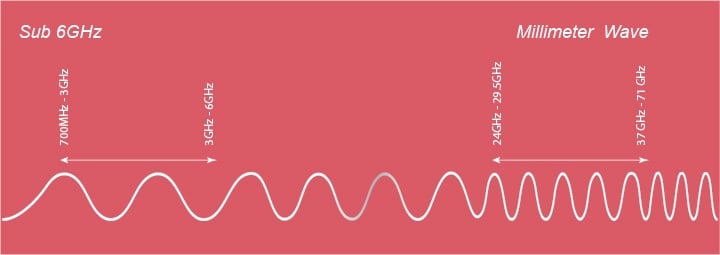5G Brings New Opportunities and New Challenges
Filtering the NR frequencies does not have to be a mystery
This page is a collection of resources to help navigate some of the issues and options when considering filtering for a 5G system.
Introduction to 5G
5G is a broad category of innovative technologies that will transform wireless communications.

For Mobile Users:
Enhanced Mobile Broadband (eMBB)
eMBB will enable increased mobile capabilities, with three distinct attributes:
- Higher capacity – Increased broadband access in densely populated areas
- Enhanced connectivity – Increased broadband access everywhere
- Higher user mobility – Broadband access in moving vehicles including cars, buses, trains and plane

For Fixed Broadband Users:
Fixed Wireless Access.
Distinct from the advantages 5G brings to mobile, Fixed Wireless Access (FWA) is a way to provide high performance broadband access to homes and offices through wireless. This aspect of 5G leverages millimeter wave (mmWave) frequencies.

For connected devices, equipment and infrastructure components:
Internet of Things.
The increased capacity and reduced latency that 5G brings will further fuel the growth of IoT (Internet of Things) applications.
5G Frequencies
As innovation in 5G encompasses a wide range of technologies and use cases we see a range of frequencies being deployed depending on the use case.

From 1GHz to 6GHz we encounter the familiar LTE bands. This region is being looked at for use cases that need of the order of 100MHz of bandwidth, with the 2.5GHz Band 41 and 3.5GHz (42+43) regarded as candidates for 5G enhanced Mobile Broadband (eMBB) applications
Frequencies below 1GHz in the UHF perform well in applications that require long range and high data rates – these are the frequencies we are used to seeing in Macro base station applications. Moving forward to 5G they will be leveraged for lower data rate and narrow band applications (such as already used in 4G IoT applications) and are looked at for the ‘massive Machine to Machine Type Communications’ (mMTC).
Starting at 28GHz we find the cm-wave and mmWave frequencies that are being utilized in Fixed Wireless Access (FWA) applications. It is these frequencies that are being deployed first.
You can learn more about the 5G Frequency Spectrum and some of the aspects of mmWave in our Blog Post An Introduction to the 5G Frequency Spectrum
The millimeter-wave part of the electromagnetic spectrum is at the high end of the microwave region (which spans ~300 MHz to 300 GHz) and is usually taken to mean frequencies from ~30 GHz to 300 GHz and wavelengths in the range of 1mm to 1cm. The ITU designation for the band spanning 30 GHz to 300 GHz is EHF (Extremely High Frequency).
One of the characteristics that makes this part of the spectrum so interesting to communication applications is that the frequencies are that much higher than those historically used in wireless so the available spectrum in the mmWave potentially opens up 200x the spectrum available below 3 GHz.
From a dramatic increase in available bandwidth comes an increase in achievable data-rates, making these frequencies extremely interesting to teams around the world working on 5G communications. However, with this increase in frequency comes a set of challenges.
Addressing Filtering Challenges in 5G
One of the challenges that engineers now face is how to sufficiently implement high-performance RF filtering in mmWave applications.
Knowles Precision Devices (DLI) Filter Technology is a proven approach to addressing the challenge of implementing high performance filters at mmWave frequencies for 5G applications.
We provide:
- 5G Band Offerings
- Surface Mount Assembly up to 42 GHz
- Extremely High Repeatability through Precision Thin Film Fabrication
- Temperature Stable over -55 to +125°C
You can learn more about Knowles Precision Devices Filter Technology through our brochure and Microwave Products page and through the resources listed below






















